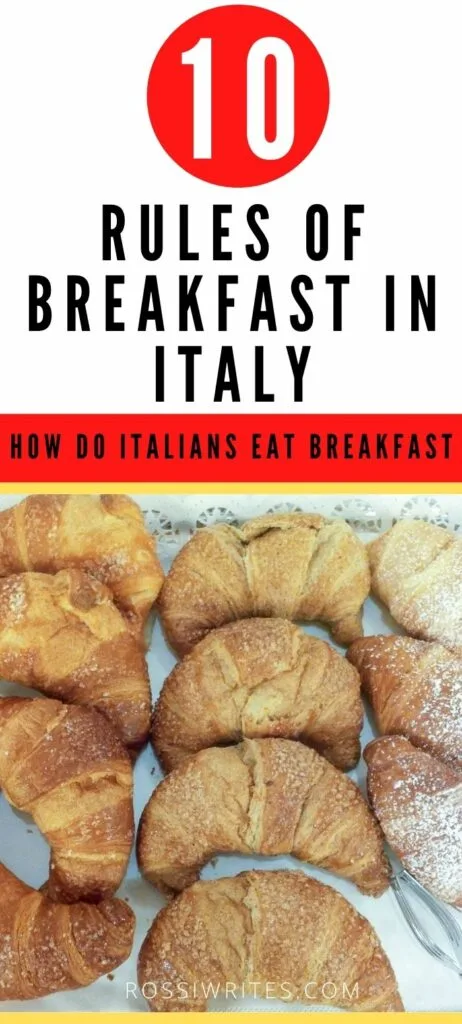The traditional Italian breakfast is small, sweet, and based on pastries and milky coffee.
The first time that you are faced with it, you may actually think: ‘Is that all?!’.
Especially, if you come from a culture where breakfast is a large-size savoury meal with many different components.
For example, in England they eat baked beans and sausages for breakfast. And in the USA, they fry bacon and eggs in the morning. Instead, the most common Italian breakfast consists of a small pastry or even a thin slice of cake taken with a small cup of cappuccino.
Eaten almost on the go, breakfast in Italy – or colazione as they call it in Italian – is not really designed to sustain you. Instead, its aim is to kick-start your digestion for the day and to give you a quick burst of energy.
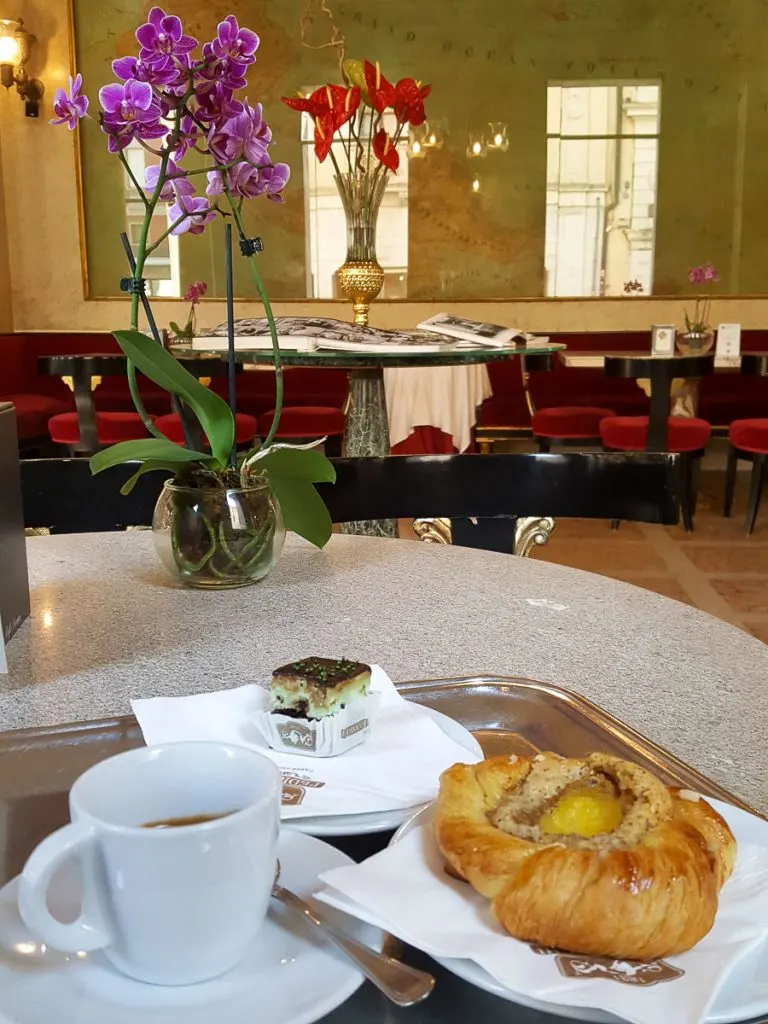
Like many other things in Italy, breakfast here, at a first glance, may seem like it doesn’t make much sense. Yet, when you know how it works and why it’s structured the way it is, it all becomes very clear and logical.
You may be planning a trip to Italy, perhaps you are being relocated there for your job, or you may simply want to find out how they do breakfasts in Italy. Fear not! Here are ten rules to follow to make your introduction to the typical Italian breakfast smooth, easy, and above all, delicious.
I formulated these ten rules myself based on my six years of living in Italy. A time that I spent (in no small dosage) enjoying hundreds of Italian breakfasts and doing research in my favourite food library in Vicenza in the north of the country.
All this first-hand knowledge coupled with my first-hand informal observation of both Italians and visitors to Italy at breakfast time is condensed in this blog post. I hope that you will enjoy reading it!
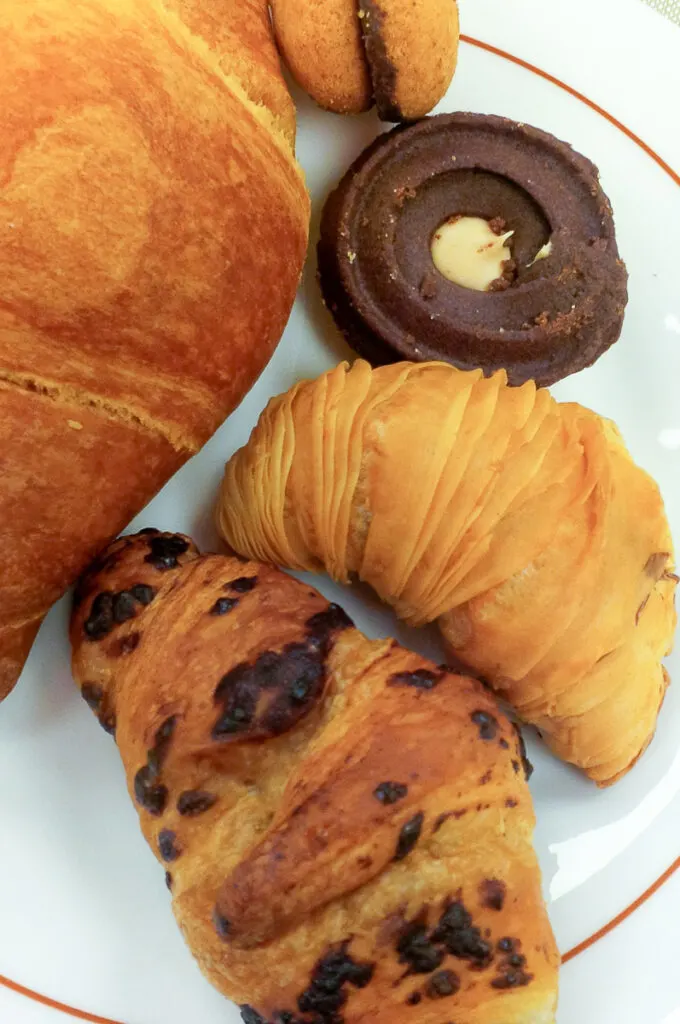
To delve even deeper into the topic of Italian breakfast, make sure that you also check my list:
It gives you details about the origins of and the traditions behind the most popular breakfast foods and drinks in Italy – from cornetto (also called brioche in Northern Italy) to the delicious frollini biscuits.
While my experience of breakfast in Italy and my writing about it are strictly personal, I hope that you will find the information provided herewith useful to prepare you in a fun yet encompassing way about your first Italian breakfast.
Enjoy!
10 Rules of Breakfast in Italy or How Do Italians Eat Breakfast
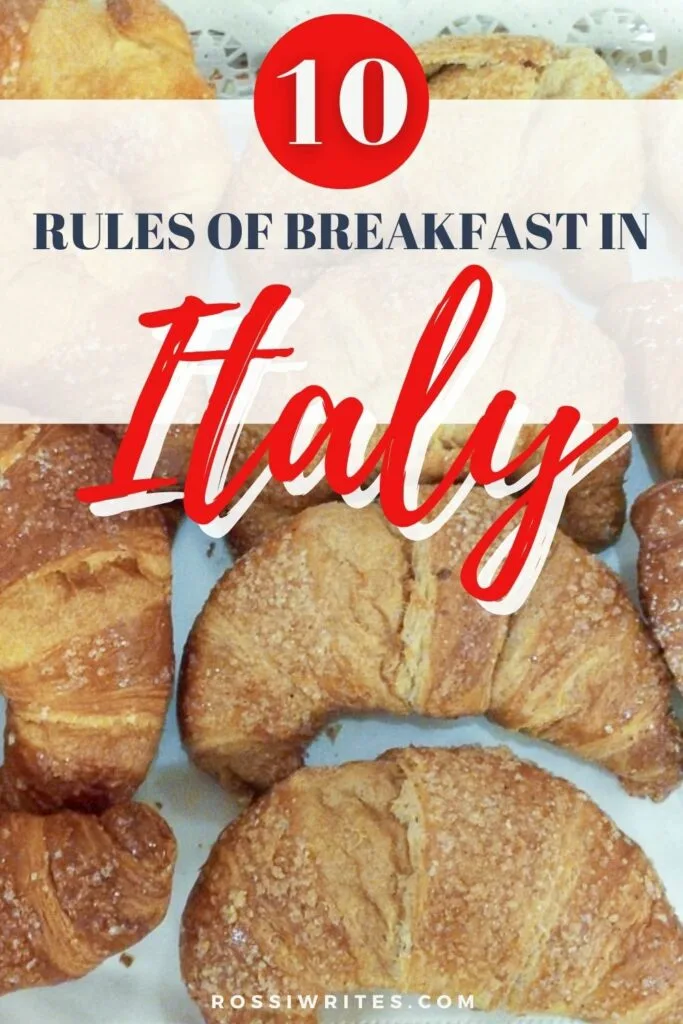
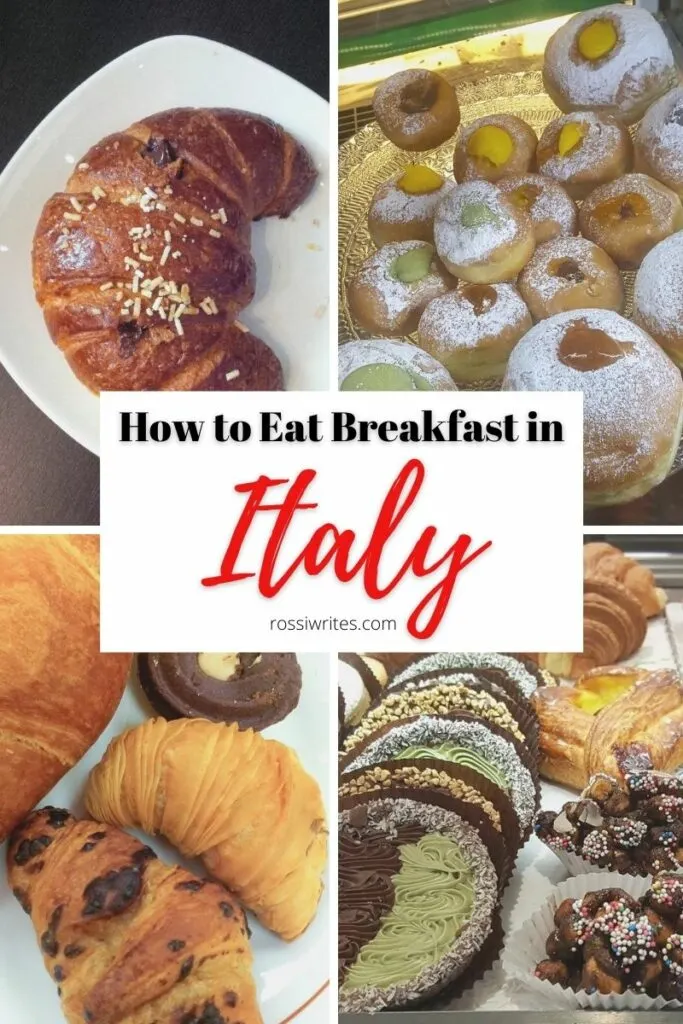
1. Italian Breakfast is Small in Size
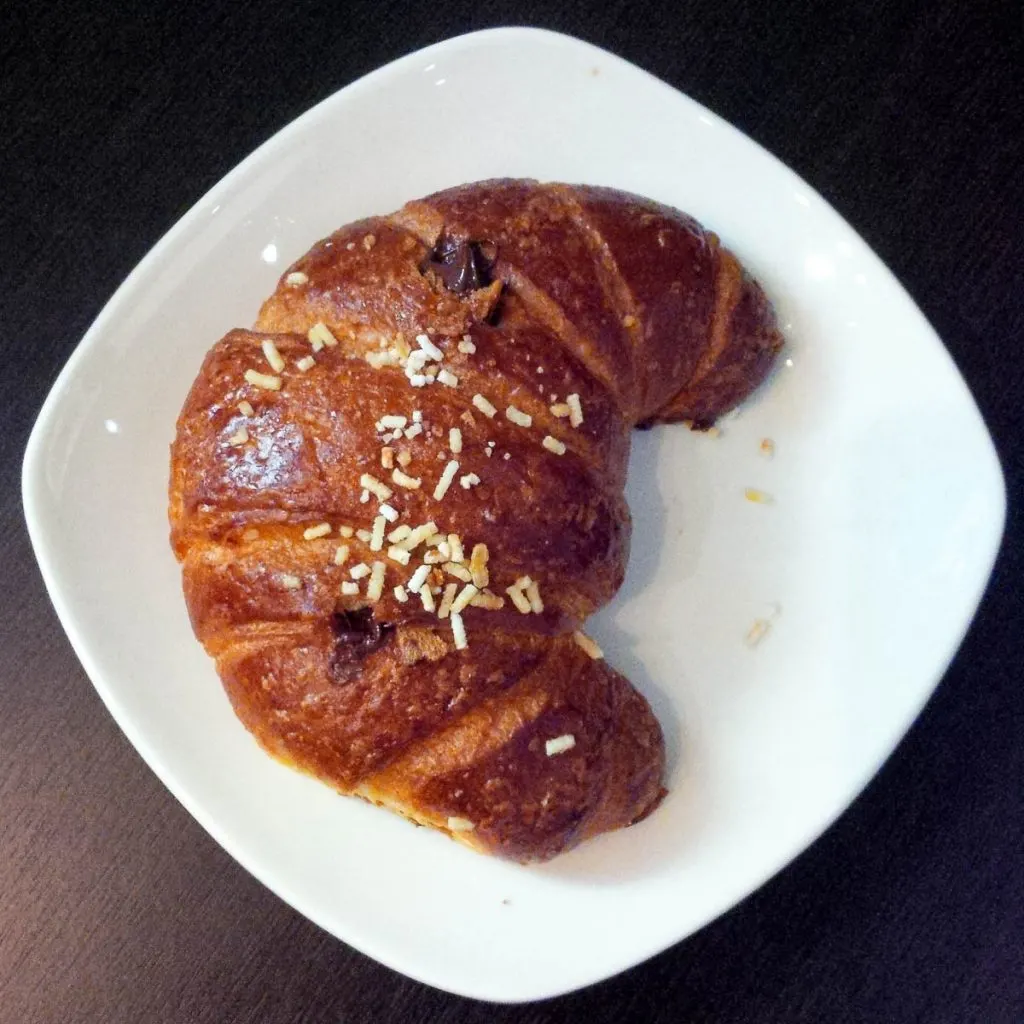
Unlike the traditional English breakfast, for example, which is served piled up on a large plate, breakfast in Italy is very small in size. All in all, the authentic Italian breakfast has two or three components at most: a drink, a small bite to eat and sometimes a piece of fruit or a small pot of yoghurt. The drink is usually milky coffee with children having some milk or juice instead. The small bite to eat is something like a bread roll with butter and jam, a couple of biscuits, or a pastry.
There are several reasons for this restraint at breakfast time in Italy. Some of them are:
- Breakfast is not the main meal of the day in Italy – it’s more like a quick burst of energy to get you going in the morning not a feast to linger over.
- Italians have dinner quite late at night – so, the idea is that they don’t need to load themselves with heavy food first thing in the morning.
- Italians are very mindful of portion control – speaking in general, food culture is exceptionally high in Italy. There is a good understanding of how food and digestion work. People are aware that you don’t need excessive amounts of food to function. As a society, Italy favours the concept of la bella figura – where a person should always look their best in terms of physical appearance and social behaviour. Eating excessively and without need goes against this concept.
Obviously, as a visitor to Italy, you are under no obligation to adhere to all this. Hotels and other types of accommodation in Italy often provide a much richer selection of breakfast foods, including English breakfast options.
Yet, if you are staying with an Italian host, a small B&B or if you simply want to have your breakfast at the local bar or pasticceria like many Italians do each morning (for more of this see point 6 below), then your breakfast choices and their size will be the ones typical for Italy.
2. Breakfast in Italy Doesn’t Take Long
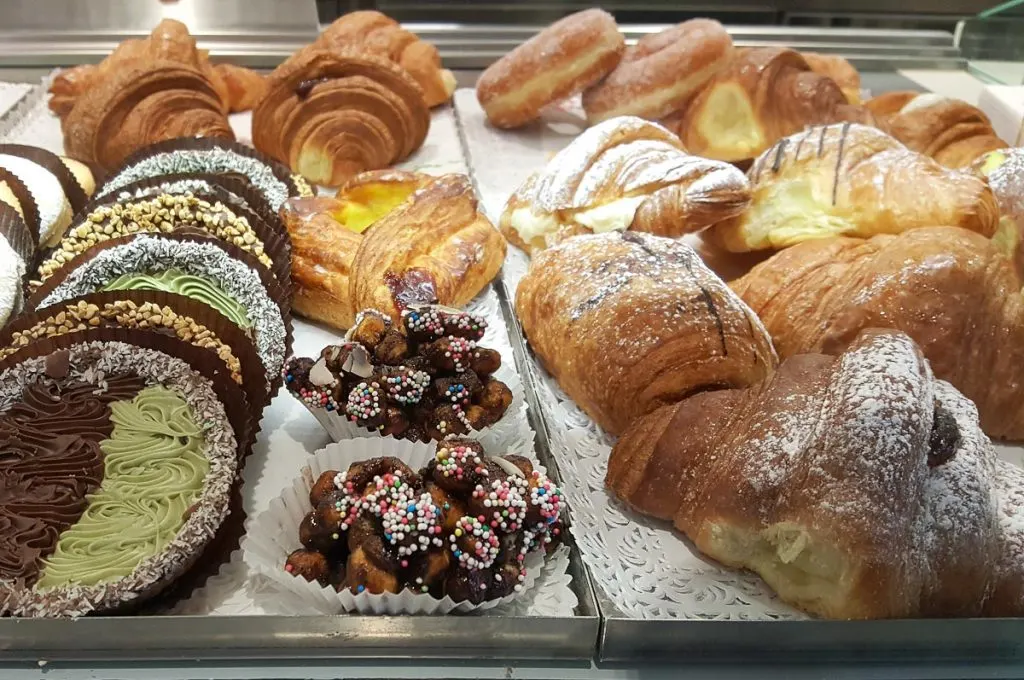
Breakfast in Italy is a quick affair. You have it almost on the go. It’s a blip between getting ready in the morning and leaving the house.
In fact, a poll of just under 1,000 Italians conducted by YouGov Italy in 2019, established that on working days people here spend on average 13 minutes on breakfast each morning. On weekends, breakfast in Italy still takes only 18 minutes on average.
In all honesty, when all you have for breakfast is a couple of biscuits and a cup of cappuccino, even 13 minutes seems like too much time spent on munching.
3. Italian Breakfast is Sweet
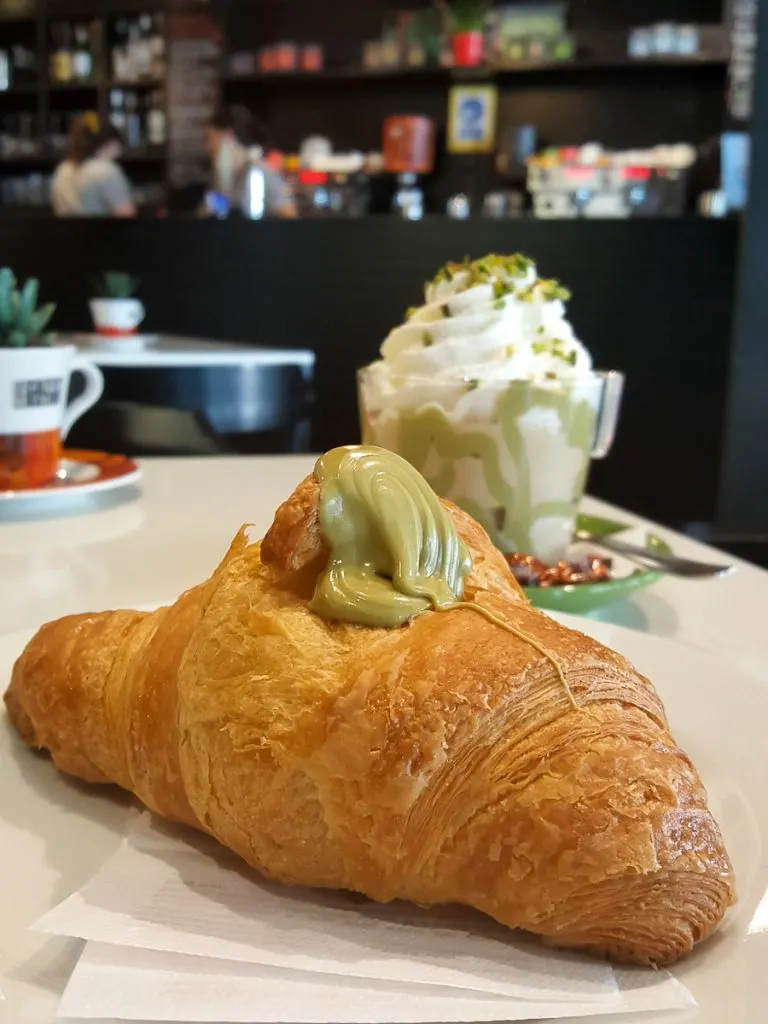
Italians eat predominantly sweet things for breakfast. This can be quite a shock if you are used to having toast, eggs, and bacon first thing in the morning.
Instead, the traditional breakfast in Italy relies almost exclusively on baked goods like biscuits, cookies, pastries, rusks, and cakes. If you go to the website which the Unione Italiana Food set up specifically to promote the value of the Italian breakfast, you will see that the photos in its header are exclusively of sweet things to eat: jam, biscuits, a slice of bread with a thick layer of chocolate spread. You get the idea!
The website is called Io Comincio Bene which in English means literally ‘I Start Well’. It was set up to share stories about breakfast in today’s Italy.
It has to be said though that while Italy eats a sweet breakfast each morning, the level of sweetness here is very measured. And, again, portion control is very tight. Everything is small and restrained. Biscuits (or cookies), for example, are quite dry (and as such perfect for dipping) and compact. You are supposed to have a couple of biscuits at most. Not the whole pack! Breakfast cakes are mainly fruit or jam-based, have a dry base, and you are expected to have a small slice. And if you opt for pastries, you pick just one.
If you look at the back of a bag of made-in-Italy biscuits, often, there is a recommendation printed on it giving you a good idea of what in Italy is considered a good breakfast – a couple of biscuits, a piece of fruit, and a small pot of yoghurt. 300-400 calories at most.
4. Italian Breakfast Has Regional Nuances
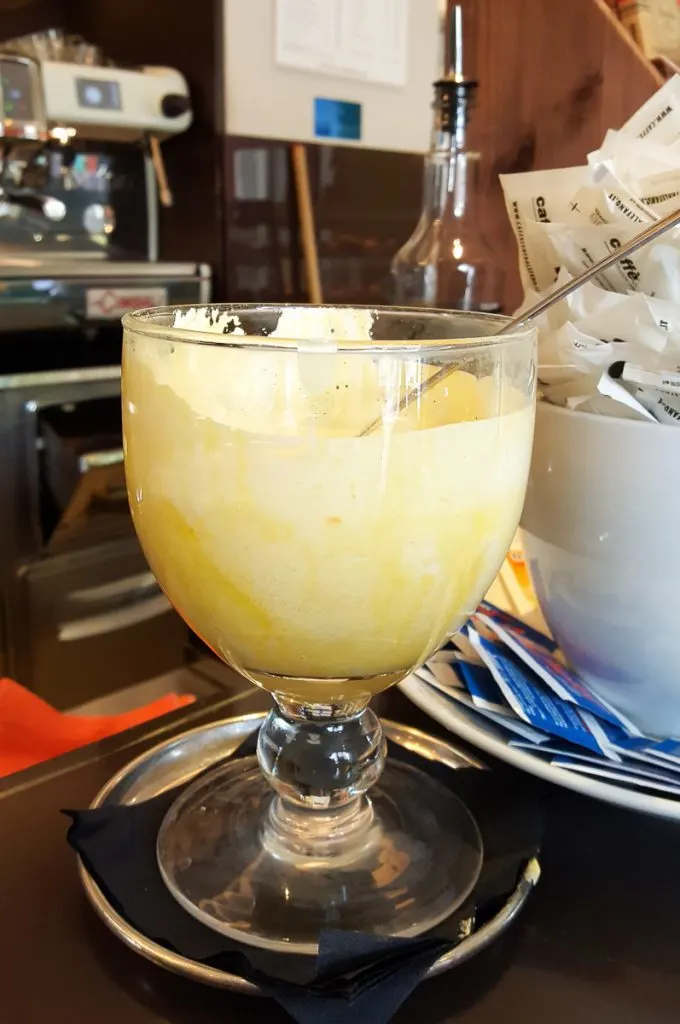
As with everything in Italy, breakfast here has regional nuances, too.
The typical Italian breakfast nowadays is based on coffee, milk, and baked goods. Still, there are some breakfast items that are particularly popular in certain Italian cities or areas rather than all over Italy.
One such breakfast food is the so-called uovo sbattuto (literally, beaten egg). The basic recipe is ancient. Basically, this is egg yolk that is beaten with sugar into a uniform pale mixture. It is then eaten as it is or used to dip biscuits or ladyfingers in it. Often, a spoonful or two of uovo sbattuto are added to the morning coffee, too. Apparently, it was a popular way to get in quickly the calories needed to engage in agricultural tasks.
In the Northern Italian region of Lombardy, they also add a small glass of sweet Marsala wine to the yolk and sugar mixture and call it resumada or rusumada.
I remember coming across my first uovo sbattuto in a cafe in the town of Fano in the Central Italian region of the Marche. The large cup with beaten eggs sat on top of the counter and the patrons could use the communal spoon to top up their coffees the old-fashioned way.
Another regional breakfast item I truly enjoyed having in Italy was roasted chestnuts served with natural yoghurt generously drizzled with honey. It’s typical for Trentino – an autonomous Northern Italian province. The cuisine of Trentino is a wonderful mix of Tyrolean and Italian influences. Another thing they eat for breakfast here is the so-called Kaiserschmarrn. This is a thick pancake studded with raisins and sprinkled with sugar. Truly delicious! If you want to read a bit more about Trentino and its cuisine, please, click here and scroll a bit down the page to the pertinent bits.
In the Italian capital Rome you can enjoy a delicious maritozzo (pl. maritozzi) for breakfast. This is a sweet roll stuffed full of whipped cream.
If you are interested in regional Italian breakfast foods, I recommend the Instagram account Colazione Napoletana. Their photos of authentic breakfast cakes, biscuits, and sweets held against the stunning backdrop of Naples are simply mouth-watering and life-affirming.
5. Italian Breakfast Has Changed Significantly Throughout the Centuries
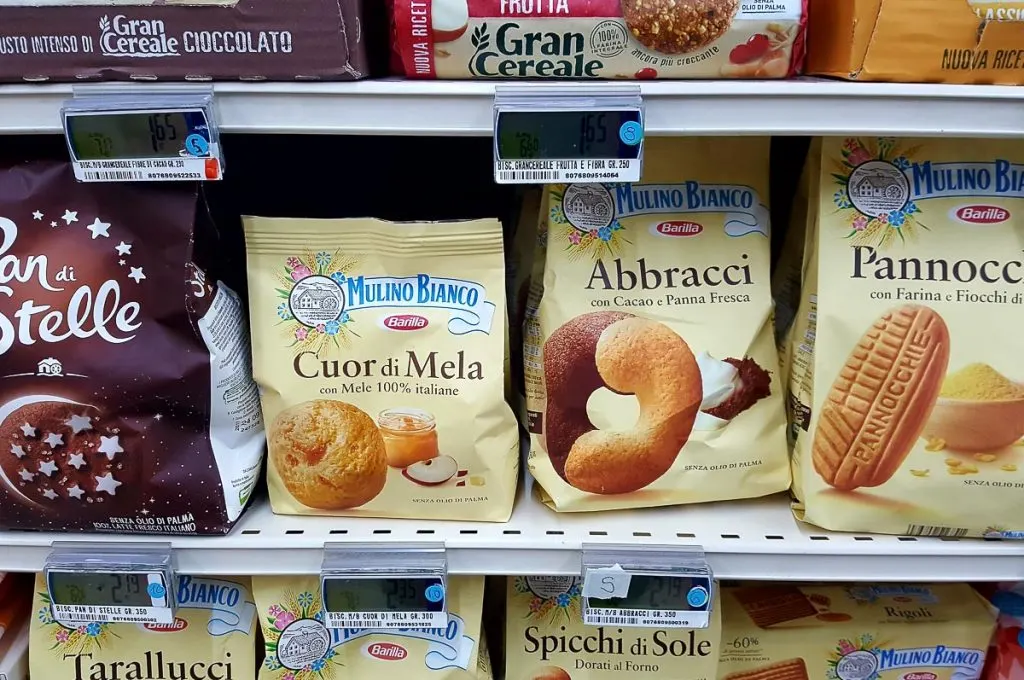
It’s interesting to note that the Italian breakfast as we know it nowadays was largely shaped in the 1960s and 1970s.
I once spent a very nice morning in Vicenza, Italy having coffee and cakes with an Italian lady who researches food traditions and used to have her own little trattoria there. ‘Why do Italians eat sweet things for breakfast?’, I asked her. At the time I was really puzzled that Italians eat sweet breakfasts while they seem to constantly worry about their appearance and weight.
Her reply was really elucidating. As is often the case in terms of food history, throughout the centuries food choices in Italy were largely dependent on the economic status of those making them. In other words, you ate what you could afford to buy or were able to grow or forage yourself.
As such, the upper classes had access to all sorts of foods including expensive refined flours, sugars, and sweets. They would eat pastries and cakes to show off their social status. They also had access to French and Austrian foods and cooking techniques.
Some of these ‘foreign’ recipes were adopted so widely and assimilated so fully that nowadays they are completely Italian. A case in point is the cornetto (called brioche in Northern Italy). Today, this is one of the most typical Italian breakfast foods while originally it was based on the Austrian kipferl.
The peasants, instead, would start the day by eating for energy – slices of polenta, some beans, dry bread dipped in milk, the leftovers from the evening’s meal, and even coffee fortified with wine.
And then, the middle classes – always growing in numbers – would try to emulate the eating habits of the more affluent social group.
In the 1960s, with the industrial advances of Italy and its economic miracle, eating dry bread for breakfast already had too many connotations of poverty. Hence, biscuits quickly gained a footing on the Italian breakfast table as a richer, sweeter yet flour-based milk-dipping alternative.
By the end of the 1970s, most Italians regularly ate biscuits for breakfast. Large producers like Mulino Bianco developed and marketed a range of shortcrust biscuits – the so-called frollini – specifically to be eaten in the morning.
To this day, you can see large bags of biscuits sold in Italian supermarkets. There are many different varieties. Pan di Stelle, for example, are incredibly popular and a staple of many Italian childhoods.
6. Bars Serve Breakfasts in Italy
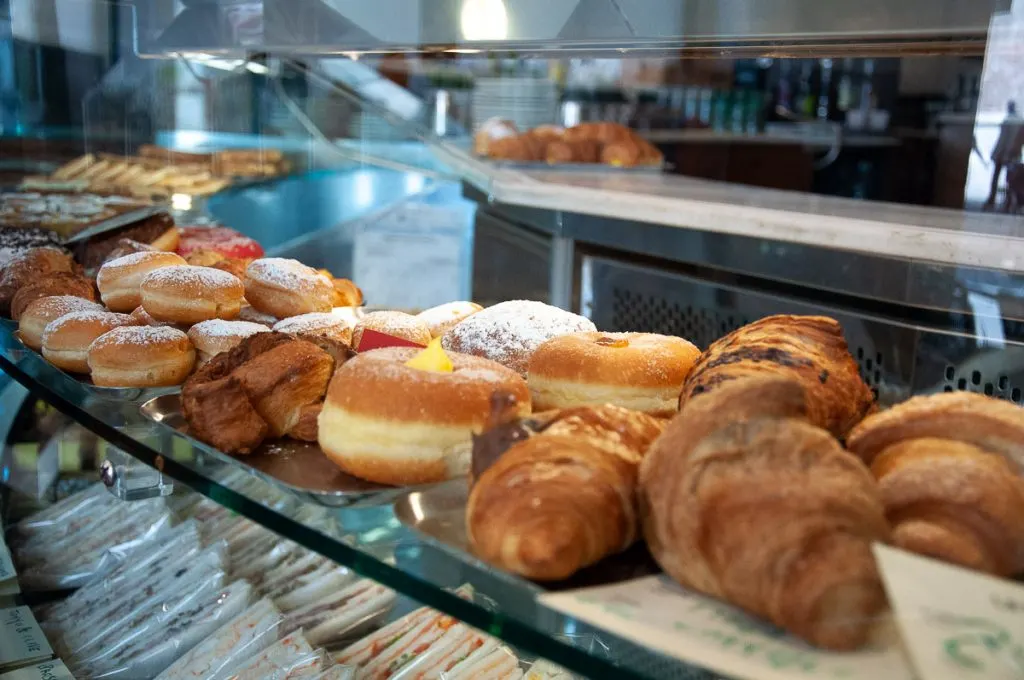
Curiously enough, many Italians have their breakfasts at the local bar!
You know how all over the world a bar is a place where people go mainly to drink alcohol and to meet with friends after work?! Well, a bar in Italy is a bit different from that.
Italian bars open early in the morning and operate all throughout the day. They are a perfectly fine place to visit with your kids. They are also the place to order a traditional Italian breakfast – a pastry coupled with a cup of cappuccino or espresso if you don’t drink milk.
The pastry, usually, is a cornetto (which is called brioche in Northern Italy). A cornetto/brioche is shaped like a croissant but it’s larger, much less flaky, and it comes with one of many different fillings – jam, chocolate, creme patisserie (called crema pasticcera in Italian) and even honey or pistachio spread.
There are other breakfast pastries in Italy, too. I really liked the so-called fagottini which my local patisserie in Vicenza prepared with a finger-licking filling of raisins.
An Italian panificio and pasticceria are two other places to get a typical Italian breakfast.
A panificio in Italy is a bakery where they bake fresh bread and prepare several pastries and snacks. You can buy your breakfast pastries here to take away. Just bear in mind that, usually, a panificio doesn’t sell coffee.
A pasticceria in Italian means literally a patisserie. It sells all sorts of sweets and cakes in addition to great coffee and other hot and cold drinks, too. Traditionally, everything is prepared and baked on-site.
It really pays to find a nice panificio or pasticceria in Italy and order your breakfast there. Freshly-baked pastries and excellent coffee can easily be the highlight of your Italian morning.
7. Breakfast in Italy Is a Very Cheap Meal
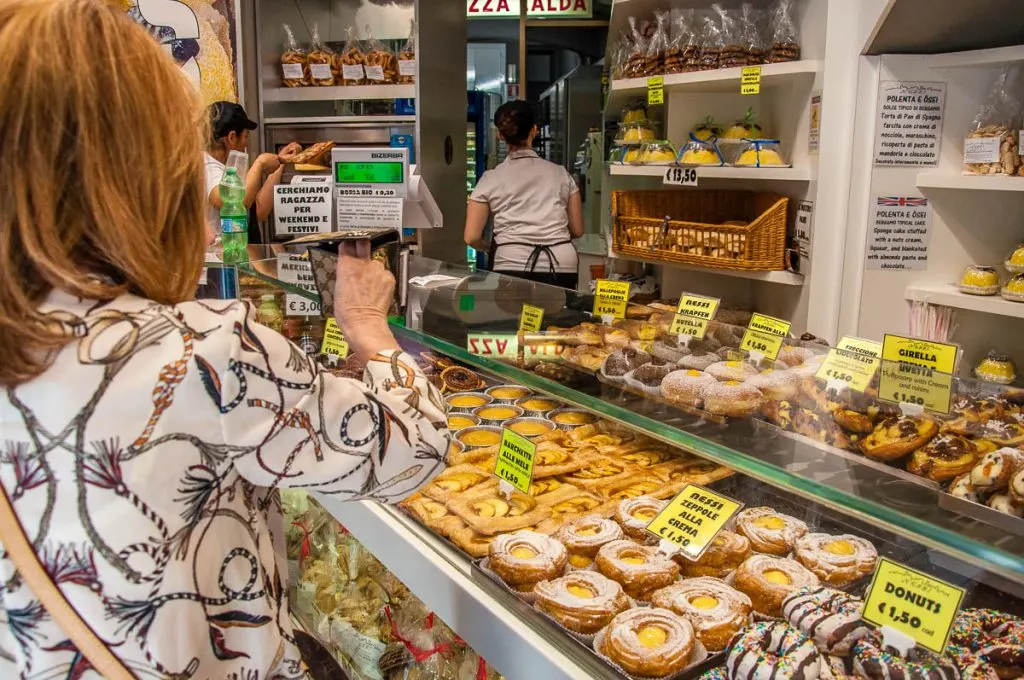
Breakfast in Italy is not only small and sweet but it is also a very inexpensive meal. A cornetto/brioche can cost anything from 1.10 euros to 1.60-1.80 euros depending on the filling. An espresso starts from 1.00-1.10 euros and rarely costs more than that.
If you want to savour different Italian breakfast pastries, just head to a different bar, panificio or pasticceria each morning and experiment.
Alternatively, a large bag of Mulino Bianco biscuits costs around 2.00-3.00 euros at most. If you follow the Italian custom of eating only two or three biscuits for breakfast, the bag is bound to last you a while.
The most expensive and yet least essential component of an Italian breakfast is the fruit juice sold in bars and pasticcerie. For some reason, both freshly-squeezed and boxed juice in Italy can cost anything from 3 euros per small cup upwards. A box or a bottle of juice bought from the supermarket is about a euro or two (depending on the brand, quantity, and the type of fruit). A much better option is (if your accommodation has the facilities) to buy fresh seasonal fruit from the local market and juice it or squeeze it yourself.
8. You Can Have Bad Breakfasts in Italy
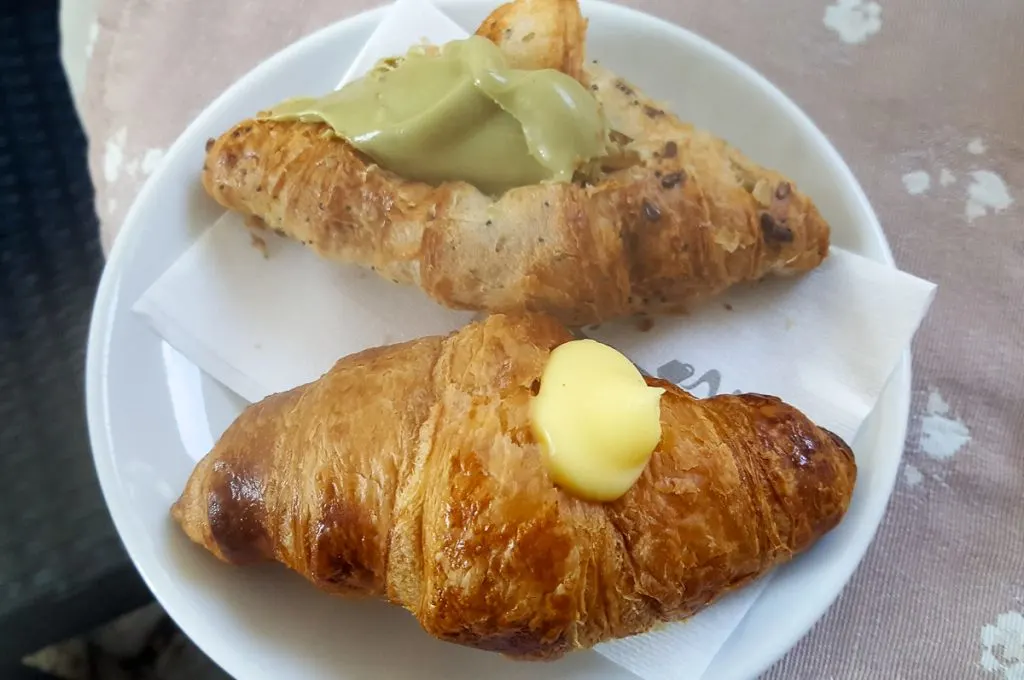
Italy is famous all over the world for its food. Yet, you can still end up having a bad breakfast during your Italian holiday.
Generally speaking, there are two pitfalls to avoid:
Hotels or other types of accommodation in Italy serving bad breakfast
Believe it or not, there are still hotels (or other types of accommodation) in Italy with a bad breakfast game. These are establishments that offer very limited and/or unappetising breakfast choices. Like the hotel in San Remo that I had the misfortune to stay in some years ago where they served us one small piece of bread and one small spoonful of jam each for breakfast. I mean, I know that the typical Italian breakfast is small in size, but this really took the biscuit!
To avoid this pitfall, when you book your accommodation, make sure that you read the reviews carefully and see if the respective hotel has uploaded photos of their breakfast table.
Several years ago I was booking a hotel in Venice for a solo trip that I wanted to take during the city’s famous Carnival. I chose a very nice hotel in a beautiful Venetian palazzo overlooking a small campo just next door to St. Mark’s Square. All the reviews said that breakfast was no good there but in my infinite wisdom I thought: ‘How bad can it be?! I am not a fussy person after all! Food is food!’
It was bad! Every morning, in the large breakfast room, under the lavish Murano glass chandeliers we were served one small dry bread roll and one pre-packaged croissant. It was beige, carby, and tasteless. I only had it once. Then I thought that life is too short to have bad food in Italy and headed to a different patisserie each morning bypassing the breakfast room on the way out.
And yet, sometimes, you do your research, read all the reviews, check all the photos, and still, your Italian hotel ends up serving subpar breakfast. Imagine sweaty slices of highly processed cheese and ham and pre-packaged pastries!
What to do? Just cut your losses! Again, life is too short to have a bad breakfast in Italy. Just go to a local bar, panificio or pasticceria, order their most delicious-looking pastries, and enjoy!
Pre-packaged Pastries
Pre-packaged pastries are the other pitfall to avoid in terms of breakfasts in Italy. I am talking about factory-produced cornetti/brioche or other Italian pastries. They are sold individually wrapped in plastic, five or six to a pack.
You will find them sold in all Italian supermarkets. They cost anything from a euro and a half to two-three euros depending on the brand and filling.
I know they are cheap and convenient to carry around but they have nothing to do with the breakfast pastries served in the Italian bars and patisseries. I find them very processed and difficult to chew. Their texture is very soft and each bite sticks to your teeth.
So, my suggestion here is to always go for the real thing!
9. You Can Have the Best Breakfasts in Italy

And yet, you can have the best breakfasts in Italy.
As long as you understand how the typical Italian breakfast works and as long as you are open to new culinary experiences, you can eat beautifully at breakfast in Italy.
Toasted slices of panettone in winter, freshly-baked crostata pies and cakes in summer, delicious brioche at any time of the year. All coupled with a variety of freshly squeezed juices and simply the world’s best coffee.
It doesn’t even have to be a five-star luxury establishment. I have had wonderful, tasty Italian breakfasts in small hotels, tiny B&B’s, and agriturismi.
A memorable breakfast we had was in a small B&B in the medieval village of Pierosara in the Marche, Central Italy. In the morning, we were presented with the large tray pictured above. There were freshly-baked brioches, slices of crostata, yoghurt, bread, cereal, and a Moka pot filled with fragrant coffee. It was simple and yet it featured all the typical Italian breakfast foods in one delicious spread. It made for a great start to a wonderful day of exploration and sightseeing.
Another truly exciting breakfast that I had the chance to enjoy in Italy was in a small guest-house in the town of Comacchio in the Northern Italian region of Emilia-Romagna. In the morning we were treated to such a large spread of cakes and pastries that it looked like we had walked into a fully stocked patisserie.
10. Italian Breakfast Keeps Evolving
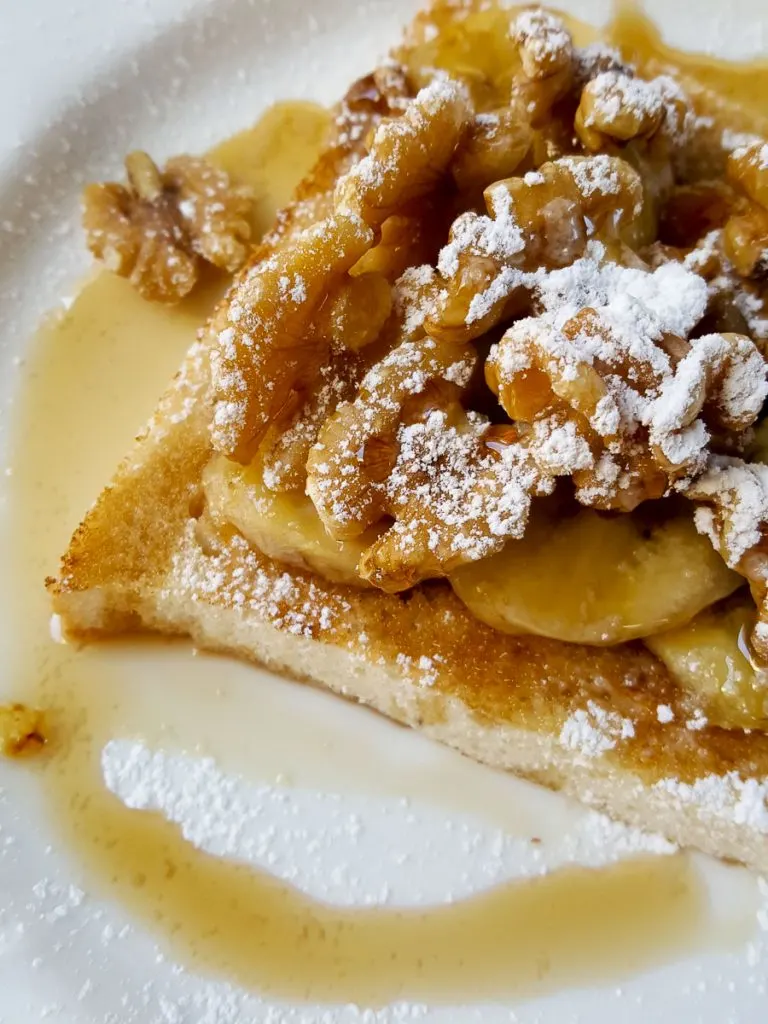
While Italian breakfast nowadays is based primarily on coffee, milk, and baked goods, it hasn’t stopped evolving.
Cereals, muesli, and yoghurt entered the Italian breakfast vocabulary in the 1980s and the 1990s. While not as popular as the omnipresent frollini biscuits and cornetto/brioche, they are here to stay. Hence, you will find a good variety of cereals and yoghurts both sold in the Italian supermarkets and offered at the breakfast table of most Italian hotels.
In the historic centres of the larger Italian cities, you can also come across nice cafes catering to wider (and even foreign) breakfast tastes. Bar Borsa in Vicenza, for example, was quite famous for its brunches. And I had the whimsical toast pictured above in the always lovely Caffeine Bar in Padua.
Plus, based on the poll quoted under point 2 above, 7% of Italians nowadays eat a savoury breakfast of toast, cheeses, sliced salami, and eggs.
Who knows how things are going to evolve in the future?! In the meantime, make the most of the typical Italian breakfast during your visit to the bel paese!
N.B.:

If you can’t or won’t have a sweet breakfast, then by all means contact your accommodation in Italy in advance to double-check that your needs will be met accordingly. Most Italian hotels nowadays provide excellent savoury options in the shape of local hams, salami, eggs, cheeses, and toast. Some add scrambled eggs, even bacon, and sausages.
If you are staying at a self-catering accommodation, then you can easily stock on great quality savoury foods from the local supermarkets, delis, and markets.
In Conclusion
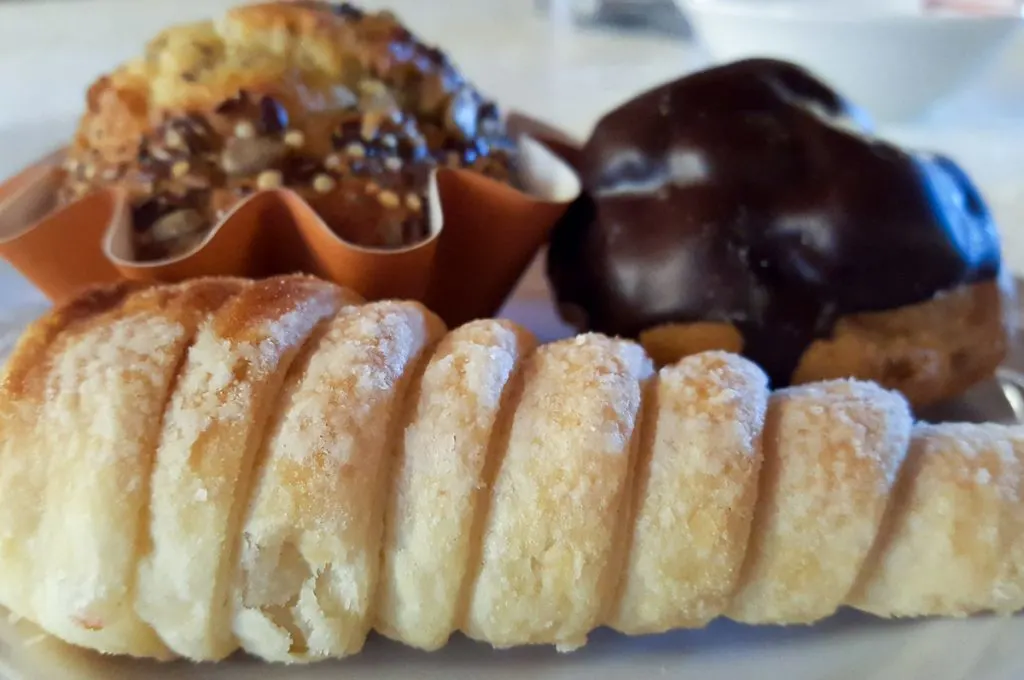
The traditional Italian breakfast relies heavily on a mix of coffee, milk, and baked goods. It’s also small in size and sweet in taste. Qualities that often leave first-time visitors to Italy a bit perplexed.
Based on my many Italian trips over the last 16 years (six of which I spent living in Northern Italy), I have described the main things to know about breakfast in Italy in this blog post.
From what to expect in terms of typical Italian breakfast foods and portion sizes to where to order the best breakfast in Italy, I have provided lots of practical details and first-hand tried and tested tips to make your Italian breakfast one to remember.
I hope that this blog post will come in handy when you are choosing what to have for breakfast in Italy.
Have a delicious Italian adventure!
More Helpful Food in Italy Info for You
Food in Italy: Typical Italian Breakfast Foods, Best Italian Food Gifts, Cheap Food in Italy, Italian Cheeses, Traditions of Panettone, What is Polenta, Caperberries, Mandorlato Veneto, Venetian Fritella, Sant’Antonio Cakes, Making Prosciutto, Arrosticini, Tortellini, Cremino
Food Festivals in Italy: Chestnut Festivals, Truffle Festival, Cherry Festivals, Pea Festival, Prosciutto Festival, Chocolate Festival
Coffee in Italy: Italian Coffee Culture, Cold Coffee Drinks, 101 Facts About Coffee, 21 Italian Coffee Drinks
Markets in Italy: Rialto Fish Market, Padua Market, Types of Markets
More Helpful Italy Info for You
Best of Italy: Italy Gift Guide, Italian Piazzas
Northern Italy: 10 Reasons to Visit, 18 Best Cities to Visit, Major Airports
Lake Garda: Best Towns, Nearest Airports, Travel Options, Lake Garda with Kids
Lake Como: Things to See, Nesso
Veneto: Best Cities to Visit, Top 15 Places, 30 Adventures, 15 Most Colourful Places
Friuli Venezia Giulia: Venzone, Most Beautiful Villages
Emilia Romagna: Bologna, Ravenna, Comacchio, Most Beautiful Villages
Marche: 6 Reasons to Visit, Gradara, Frasassi Caves, Temple of Valadier
Trentino: Cities and Towns in Trentino, Rovereto, Lakes in Trentino, Lake Caldonazzo, 15 Amazing Places
Venice: Essential Tips, Major Landmarks, Hidden Gems, How to Navigate Venice, Venice in a Day for Art Lovers, Train Stations, Nearest Airports, Best Tours, Boats in Venice, Haunted Venice, Day Trips from Venice, Arco del Paradiso
Verona: Things to Do in One Day, Verona Opera Festival, Day Trips from Verona
Padua: Things to Do in One Day, 101 Facts About Padua, 10 Reasons to Visit Padua, Day Trips from Padua
Vicenza: Things to Do, Best Museums, Day Trips from Vicenza
Day Trips in Italy: Bologna to Verona, Milan to Verona, Venice to Verona, Bologna to Venice, Milan to Venice, Florence to Venice, Verona to Venice, Venice to Padua, Venice to Lake Garda, Milan to Lake Garda, Verona to Lake Garda, Bologna to Lake Garda
